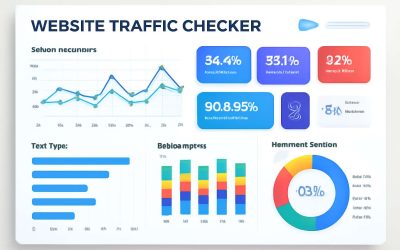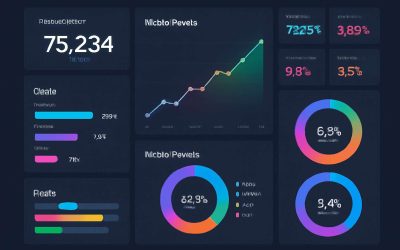Best Tools for Monitoring Website Traffic
Google Analytics – Comprehensive analytics platform for detailed website traffic insights
In the shadowed corridors of digital influence, knowing where to check website traffic can be the difference between obscurity and dominion. Google Analytics stands as a towering monolith, offering a comprehensive analytics platform that reveals the intricate patterns of visitor behaviour. Its detailed insights carve a path through the darkness, exposing which pages breathe life into your site and where visitors linger in the gloaming.
This ethereal tool provides much more than numbers; it unveils the ghostly footprints left behind by your audience. From real-time user activity to long-term trends, Google Analytics is the key to unlocking the secrets of your web visitors. For those seeking clarity amid the chaos, it’s an indispensable guide on the journey to optimise your online presence.
- Access real-time traffic data to see who is present in the digital night.
- Analyse user demographics and behaviour patterns to understand what draws them in.
- Track conversions and goal completions, illuminating the path from visitor to loyal follower.
In the vast, shadowy realm of the internet, Google Analytics remains a beacon—an essential compass to discern where to check website traffic with precision and purpose.
SEMrush – All-in-one marketing toolkit with traffic analysis features
When the digital cosmos feels overwhelming, finding reliable tools to monitor your website traffic becomes a moral imperative. SEMrush emerges as a formidable ally in this pursuit—an all-in-one marketing toolkit designed to illuminate the shadows of online performance. Its traffic analysis features don’t just present data; they offer a visceral understanding of your audience’s behaviour, revealing the hidden currents that drive visitor engagement.
Unlike conventional analytics, SEMrush allows you to peer into competitors’ traffic sources, uncovering opportunities often concealed beneath surface metrics. Its intuitive interface transforms complex data into visual stories, guiding you to where to check website traffic with purpose and precision. For those who seek a deeper connection with their audience’s journey, SEMrush’s insights become a compass, revealing the unseen forces at play.
In a landscape where every visitor’s behaviour is a fragment of a larger narrative, SEMrush provides a lens to decode these subtleties. Whether analysing organic search trends or paid campaigns, it empowers you to act with clarity and confidence—making it an indispensable part of your digital arsenal.
Ahrefs – SEO tool providing website traffic estimates and backlink profiles
In the shadowy corridors of digital influence, knowing where to check website traffic can mean the difference between obscurity and dominance. Ahrefs stands as a formidable sentinel in this realm, offering more than mere estimates. Its meticulous analysis of backlink profiles and traffic estimates unveils the underlying skeleton of your online presence, revealing unseen avenues of growth.
While Google Analytics captures the heartbeat of your visitors, Ahrefs peers into the broader web, exposing the pathways that lead audiences to your portal. Its data penetrates the surface, giving you a glimpse into organic search trends and competitor strategies. For those seeking a deeper understanding of their digital domain, Ahrefs whispers secrets, guiding your steps through the labyrinth of online engagement.
When pondering where to check website traffic, consider this: Ahrefs transforms raw numbers into a tapestry of insights, illuminating the unseen currents that drive visitor behaviour. Its tools are a lantern in the perpetual night of digital uncertainty, revealing the lurking opportunities that await discovery.
SimilarWeb – Market intelligence platform offering traffic data for competitor analysis
In the digital arena, understanding where to check website traffic can be the key to unlocking unseen potential. Market intelligence platforms like SimilarWeb wield the power to dissect your competitors’ online strategies, revealing their traffic sources and audience behaviour with startling clarity. This tool doesn’t just show numbers—it paints a vivid picture of market trends, giving you an edge in the relentless quest for online dominance.

Unlike traditional analytics, SimilarWeb offers a panoramic view of digital landscapes, exposing traffic patterns across industries and regions. Its comprehensive reports help you identify emerging opportunities and benchmark your performance against rivals. For those venturing into the depths of SEO, knowing where to check website traffic through such platforms can transform your approach from guesswork into strategic mastery. With its detailed insights, you’ll be better equipped to navigate the complex web of online engagement and stay ahead in the game.
Matomo – Open-source alternative for self-hosted website analytics
In the shadowed corridors of digital espionage, knowing where to check website traffic can be the difference between obscurity and dominance. While many tools reveal the surface, Matomo offers a clandestine alternative—an open-source beacon for those who prefer control over their analytical fate. Its self-hosted nature grants the ability to peer into your website’s soul, unfiltered and unshackled by third-party constraints.
With Matomo, you gain access to vital metrics—visitor behaviour, traffic sources, and engagement patterns—delivered in a sleek, customisable interface. Its flexibility means you can tailor your insights, making it a potent weapon in your SEO arsenal. For those who crave transparency and security, this tool is a dark horse, allowing you to scrutinise your digital domain without compromise.
For the inquisitive, a simple list often suffices:
- Real-time visitor tracking
- Customisable dashboards
- Enhanced privacy settings
Yet, what truly elevates Matomo is its capacity to transform raw data into a narrative—revealing where to check website traffic with depth and precision. In a realm where visibility is power, this open-source sentinel stands ready to unveil the unseen and illuminate the path forward.
Analyzing Traffic Sources and Behavior
Referral Traffic – Understanding external sources driving visitors
Understanding the intricate dance of website visitors begins by delving into the origins of their journey. When exploring where to check website traffic, one vital facet is analysing traffic sources—particularly referral traffic. This reveals the external gateways funneling visitors into your digital sanctuary. External sources like social media platforms, partner websites, or niche directories act as silent ambassadors, shaping your audience’s behaviour in subtle yet profound ways.
By inspecting referral traffic, you uncover the hidden pathways that lead visitors to your site. This insight paints a vivid picture of your outreach’s effectiveness—highlighting which channels truly resonate. Sometimes, a handful of referral sources can account for the majority of your traffic, transforming your understanding of where to check website traffic into a strategic advantage. Recognising these external influences allows you to craft more compelling content, optimise partnerships, and ultimately, deepen your connection with your audience.
Organic Search Traffic – Tracking visitors from search engines
In the grand theatre of digital marketing, understanding where to check website traffic is akin to having a backstage pass. Organic search traffic, in particular, is often the unsung hero—quietly funneling visitors from the mysterious depths of search engines into your virtual domain. Tracking these visitors isn’t just about numbers; it’s about deciphering intent and uncovering the keywords that truly resonate with your audience. When you delve into organic search traffic, you gain insights into which search queries are driving quality traffic and how your SEO efforts are paying off.
Sometimes, the most revealing data comes from analysing visitor behaviour once they land on your site. For instance, which pages do they linger on? Are they bouncing faster than a ping-pong ball, or are they engaging with your content? Tools like Google Analytics make it straightforward to see this behaviour, showing you where your visitors originate and how they interact. It’s a vital piece of the puzzle when deciding where to check website traffic for a comprehensive SEO strategy.
Direct Traffic – Analyzing users who enter your URL directly
In the labyrinth of digital footprints, understanding where to check website traffic is akin to unveiling a hidden map—a guide to the secret corridors leading to your audience’s desires. When visitors arrive via direct traffic, they come with a sense of familiarity, having entered your URL with purpose or curiosity. Analyzing these users reveals more than just numbers; it uncovers the character of your most loyal visitors and the magnetic pull of your brand. Are they returning customers or new explorers? Their behaviour on your site is a story waiting to be deciphered.
To truly unravel this tale, tools like Google Analytics can illuminate the journey. They show which pages captivate visitors who type your URL directly into their browser, revealing the pathways they choose and the content that keeps them engaged. Sometimes, this traffic is a whisper of brand loyalty, other times a siren call from your marketing campaigns. Knowing where to check website traffic for these insights can make all the difference—guiding the next chapter of your SEO strategy.
Social Media Traffic – Monitoring traffic from social platforms
Understanding where to check website traffic is an art as much as it is a science. Social media traffic, in particular, offers a tantalising glimpse into how your brand resonates beyond the confines of your website. Monitoring visitors arriving from platforms like Twitter, LinkedIn, and Facebook reveals not just volume but the quality of engagement. Are these visitors merely passing through, or are they engaging, sharing, and converting? Such insights can shape your content strategy and refine your outreach efforts.
To gain a nuanced perspective on social media traffic, specialised tools like Google Analytics or social media analytics platforms can be invaluable. They help you discern patterns—are your latest campaign efforts drawing in targeted audiences, or is your traffic simply a fleeting gust? By examining behaviour metrics—such as time spent on page or bounce rate—you unearth the story behind the numbers. When you ask yourself where to check website traffic, don’t overlook the social channels that act as both a mirror and a megaphone for your brand’s digital persona.
User Engagement Metrics – Time on site, bounce rate, and pages per session
Understanding where to check website traffic isn’t just about peering into a data abyss; it’s about deciphering the story behind every visitor. Once you’ve got those numbers, the real fun begins—delving into user engagement metrics that reveal what visitors truly think of your site. Time on site, bounce rate, and pages per session form a trio of vital signs, offering insights into whether your content captivates or simply causes visitors to flee faster than a cat from a cucumber. High time on site paired with low bounce rate? That’s a good sign—like a cosy chat over coffee. Conversely, a quick exit might signal your content’s not hitting the mark.
To truly grasp the nuances, consider examining behaviour metrics—these act as your digital lie detector. They help you determine if visitors are genuinely engaging with your content or just passing through. Sometimes, the answer lies in the tiniest details: which pages keep users glued, or where they drop off. Remember, when pondering where to check website traffic, don’t overlook the behavioural clues that tell you whether your traffic is casual curiosity or committed engagement. After all, understanding these metrics transforms raw data into actionable intelligence—your secret weapon for SEO mastery.
Utilizing Server and Hosting Data
Server Log Files – Reviewing raw server data to track visits and behaviors
Looking for a behind-the-scenes glimpse into your website’s clandestine traffic operations? Server log files are the digital equivalent of peeking through a keyhole into your site’s secret life. They record every visit, click, and misstep—like a digital diary that never forgets. By reviewing raw server data, you can uncover precisely where to check website traffic, revealing patterns that even the most sophisticated analytics tools might miss. It’s as if your server whispers the truth, unfiltered and unvarnished, about user behaviours and visit origins.
To truly harness this treasure trove, you’ll want to sift through the server logs regularly. Look for patterns such as IP addresses, timestamps, and request URLs—these are your breadcrumbs leading to understanding your audience. If you’re brave enough, you can even create a simple list of the most common request sources, giving you a clearer picture of your traffic sources beyond the usual suspects. Remember, while tools like Google Analytics are great, sometimes the raw data from server log files offers an unvarnished view—perfect for when you need to know where to check website traffic with surgical precision.
Hosting Provider Analytics – Tools offered by hosting providers to analyze traffic
Hosting provider analytics offer a discreet yet potent avenue for unravelling your website’s clandestine traffic patterns. Many hosting platforms furnish built-in tools—think dashboards brimming with real-time data—that can serve as an invaluable supplement to more comprehensive analytics solutions. These tools often provide a snapshot of where to check website traffic, highlighting server requests, bandwidth utilisation, and even geographic visitor distribution.
For those seeking granularity, some providers allow access to server log files directly through their control panels. This raw data can reveal fascinating insights—like which request URLs dominate your server or which IP addresses are most persistent.
- Bandwidth consumption
- Visitor geolocation
- Request frequency
Understanding these elements can be the difference between a vague notion of traffic and surgical precision in your SEO strategy. While the allure of third-party analytics remains strong, exploring the native tools offered by your hosting provider can uncover hidden traffic sources and visitor behaviours that might otherwise go unnoticed.
Content Delivery Networks (CDNs) – Monitoring traffic through CDN analytics dashboards
In the labyrinthine realm of digital presence, understanding where to check website traffic transforms from mere curiosity into strategic mastery. Beyond the polished dashboards of third-party tools, the raw, unfiltered data stored within server environments offers an almost clandestine glimpse into visitor behaviours. Monitoring traffic through Content Delivery Networks (CDNs) analytics dashboards elevates this insight—these platforms act as vigilant sentinels, capturing the ebb and flow of user engagement across global nodes.
CDNs provide a detailed tableau of request frequency, geographic visitor distribution, and bandwidth utilisation—each a vital thread woven into the intricate tapestry of your website’s traffic narrative. For the analytically inclined, examining server log files becomes an act of uncovering hidden patterns—like identifying which request URLs dominate or recognising persistent IP addresses that hint at dedicated audiences or malicious activity. This raw data becomes a canvas upon which the subtle contours of visitor journeys are painted, revealing insights that often escape conventional analytics.
By integrating CDN analytics with server data, webmasters unlock a layered perspective—an essential compass for navigating the complex landscape of SEO. Ultimately, this exploration of where to check website traffic through these sophisticated tools fosters a deeper understanding of the unseen forces shaping visitor engagement and site performance. It’s not just about numbers; it’s about deciphering the silent signals that drive digital success!
Incorporating SEO Tools for Traffic Estimation
Keyword Analysis – Identifying search terms bringing traffic
Understanding where to check website traffic can unlock hidden patterns that even the most seasoned marketers might overlook. SEO tools have become essential in unveiling search terms that drive visitors, revealing the subtle dance between keywords and user intent. By incorporating advanced traffic estimation and keyword analysis, you gain an edge in deciphering the mystery behind your audience’s behaviour.
Many professionals rely on platforms like SEMrush and Ahrefs, which offer detailed insights into search terms bringing traffic to your site. These tools not only highlight popular keywords but also help identify gaps in your content strategy. A nuanced approach involves analysing referral traffic sources and organic search metrics to refine your targeting—knowing exactly where your visitors originate from is vital in this ongoing quest for optimisation.
Backlink Data – Understanding referral traffic driven by backlinks
Understanding referral traffic driven by backlinks is a crucial part of where to check website traffic effectively. SEO tools like Ahrefs and SEMrush excel at revealing not only search terms but also backlink profiles that generate visitors. By analysing backlink data, you can identify which external sites send the most traffic and refine your outreach strategies accordingly.
Many professionals overlook this aspect, yet referral traffic analysis often uncovers valuable opportunities. Using platforms with backlink data, such as Ahrefs, allows you to see which links are most powerful and how they influence your overall traffic. This insight helps you optimise your content placement and build stronger relationships with high-authority sites.
Tracking referral sources provides a comprehensive view of where your visitors originate, offering a deeper understanding of your traffic sources and helping you identify unexplored channels. This nuanced approach ensures you’re not just guessing where to check website traffic but making data-driven decisions that boost your visibility.
SERP Position Tracking – Monitoring rankings to predict traffic changes
Monitoring your website’s performance is no longer a mere suggestion; it’s a necessity driven by the relentless pursuit of visibility. Incorporating SEO tools for traffic estimation, especially SERP position tracking, transforms the way you understand your digital footprint. These sophisticated tools don’t just show rankings—they reveal the subtle shifts that can predict traffic changes before they materialise. By continuously tracking your positions for target keywords, you gain a supernatural insight into how your efforts impact visitor flow.
Imagine spotting a trend in SERP fluctuations that hints at a surge in organic search traffic. This real-time intelligence allows you to pivot your strategy swiftly, amplifying the effect. Some platforms even offer an ordered list of ranking movements, helping you pinpoint exactly when and where your traffic is poised to spike. This data-driven approach ensures you’re not blindly guessing where to check website traffic but proactively hunting for signals that unlock new channels of visitors.
Using Social Media and Advertising Platforms
Facebook Insights – Tracking traffic from Facebook campaigns
In the labyrinthine world of digital analytics, knowing where to check website traffic becomes an essential compass for deciphering the elusive patterns of user behaviour. Among the myriad tools available, social media platforms like Facebook offer a surprisingly rich vein of insights, especially through Facebook Insights. This specialised dashboard transforms raw data into a narrative, revealing not just the volume of visitors but also their engagement levels and interaction tendencies.
By analysing traffic from Facebook campaigns, businesses can gauge the resonance of their content and optimise future outreach. This platform provides detailed metrics such as reach, engagement, and click-through rates, illuminating which posts and ads are driving visitors to the website. For a deeper dive, a strategic approach involves examining:
- Audience demographics
- Post-performance analytics
- Conversion tracking from ad campaigns
This meticulous scrutiny helps to identify the most effective channels and refine marketing strategies, ensuring that efforts are directed precisely where they yield the greatest ROI. Ultimately, understanding where to check website traffic—especially from social media—becomes an art form rooted in data-driven intuition, allowing brands to craft more compelling digital narratives that resonate deeply with their audiences.
Google Ads – Analyzing traffic generated through paid advertising
In the grand theatre of digital marketing, understanding where to check website traffic from paid advertising can feel akin to deciphering an esoteric language. Google Ads, with its sophisticated analytics dashboard, transforms raw click data into an insightful narrative about your audience’s journey. It’s not merely about counting visitors; it’s about grasping the nuanced story behind each click—what ad resonated, which keywords prompted curiosity, and how users interacted once they arrived.
By delving into Google Ads’ detailed reports, marketers can unearth valuable clues—such as conversion rates and bounce rates—that reveal the true impact of their paid campaigns. An effective approach involves examining:
- Keyword performance and relevance
- Ad placement efficacy
- Landing page engagement metrics
Such granular analysis ensures that marketing efforts are not just shot in the dark but are instead finely calibrated to drive optimal traffic and meaningful interactions. After all, knowing where to check website traffic from advertising platforms isn’t merely a technical necessity; it’s the cornerstone of strategic mastery in the digital age. And if there’s one thing more vital than a well-crafted ad, it’s knowing precisely which metrics reveal its true worth.
LinkedIn Analytics – Monitoring professional audience engagement
In the intricate dance of digital marketing, understanding where to check website traffic from social media platforms is crucial for nurturing genuine engagement. LinkedIn Analytics, in particular, offers a window into the professional audience’s behaviour, revealing not only how many visitors arrive but also how they interact with your content. This platform shines in providing insights into the quality of your traffic—are your posts prompting meaningful conversations or simply fleeting visits?
By monitoring metrics such as post impressions, click-through rates, and engagement rates, marketers can gauge the resonance of their message among industry peers. An effective way to interpret this data is through a simple list:
- Audience demographics—age, location, and professional interests
- Content performance—what types of posts garner the most attention
- Conversion pathways—how visitors navigate your website after clicking through
These insights illuminate not just where to check website traffic, but how to fine-tune outreach efforts for maximum impact. When you truly understand your professional audience, every click becomes a step closer to meaningful connections and strategic growth.
Leveraging Competitor Analysis Tools
SpyFu – Insights into competitors’ traffic and keywords
When pondering where to check website traffic, SpyFu often slips under the radar—yet it’s a treasure trove for competitive espionage. This tool doesn’t just reveal your rivals’ secret sauce; it deciphers their traffic and keywords with a detective’s finesse. Imagine having a backstage pass to their organic search strategies and paid campaigns—talk about a leg up in the SEO game!
SpyFu’s insights help businesses understand which keywords are driving traffic to competitors, enabling smarter content and advertising decisions. Plus, its historical data can unearth trends that might otherwise stay buried. For those seeking a clear picture of where to check website traffic, SpyFu’s competitive analysis features are invaluable, painting a vivid landscape of your industry’s digital battleground.
SimilarWeb – Comparative traffic metrics for industry analysis
In the shadowy realm of digital espionage, uncovering where to check website traffic can often feel like deciphering the secrets of ancient, forbidden texts. Among the spectral tools at your disposal, SimilarWeb stands as a formidable sentinel—offering comparative traffic metrics that reveal the unseen currents guiding industry giants. Its market intelligence platform exposes the hidden flow of visitors, illuminating the competitive landscape with spectral clarity.
Imagine peering through a foggy window into your rivals’ digital domain, understanding their traffic sources and audience behaviour without ever crossing the threshold. SimilarWeb’s granular insights enable you to chart the course of external sources driving visitors and detect shifts in industry trends—crucial knowledge for any SEO strategist. For those seeking to navigate the labyrinth of online competition, this tool provides an invaluable spectral map, guiding your steps through the dark corridors of the digital battleground.
Alexa – Web traffic ranking and demographic data
In the relentless pursuit of digital dominance, understanding where to check website traffic becomes an indispensable facet of strategic mastery. Among the pantheon of tools, Alexa emerges as a venerable oracle—offering not just web traffic ranking but a nuanced portrait of demographic data that paints a vivid picture of your audience’s behavioural patterns. Its ability to dissect external sources of visitors transforms opaque data into a strategic mosaic, revealing insights that often remain hidden beneath the surface.
Imagine wielding a magnifying glass over your competitors’ online footprint, uncovering detailed metrics that inform your next move. Alexa’s comparative analysis allows you to identify industry trends and audience preferences, turning raw numbers into a storytelling device that enriches your SEO efforts. For those questioning where to check website traffic, Alexa’s demographic insights serve as a compass—guiding your navigation through the labyrinth of digital engagement with precision and finesse.
- Web traffic ranking: Gauging your site’s visibility within your industry landscape.
- Demographic data: Understanding the age, gender, and interests of your visitors.
- Referral sources: Identifying which channels drive the most traffic to your competitors.
Such insights elevate your understanding beyond surface metrics, forging a deeper connection with your target audience and sharpening your competitive edge. When considering where to check website traffic, Alexa’s layered approach offers a vantage point that is both strategic and insightful—empowering you to craft SEO strategies rooted in real behavioural intelligence.




0 Comments